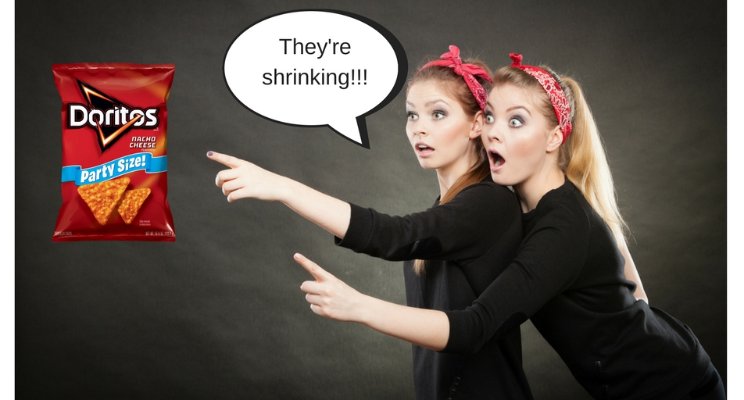When you realize that something you buy often has gone up in price, how do you feel? For many of us, my guess is annoyed, which is the type of emotion that isn’t doing the Customer Experience any favors. However, without checking the package (or Googling) do you have any idea how many sheets of tissue are on a toilet roll? Me neither.
That is what manufacturers are banking on with their strategy to reduce the amount included in your purchase price. It’s called “Shrinkflation,” and it’s getting, well, Huuuuge.
Shrinkflation is when the price doesn’t go up, what you pay per ounce (or sheet) does. It happens because the manufacturer reduces the volume of the package. From chocolate bars to toilet tissue, over 2,500 products in the UK have been getting smaller over the past five years while the price remains the same, per the Office of National Statistics (ONS). In an article about the ONS findings published by The Guardian, it seems that over two thousand of the shrinking products were food products, including:
- Toblerone, with its wide-gapped triangles that resulted in a reduction of the grams of chocolate bar from 170 grams down to 150 grams (which is 6 oz. down to around 5.2 oz. for the Yankees reading this).
- Maltesers (which are British Whoppers) from a former employer of mine, Mars, lightened its load by 15% from the sharing bags.
- Doritos also lost 20 grams from its 200-gram-sized bag, down from (so around 7 oz. down to 6.3 oz.)
- Coco Pops (British Cocoa Krispies) are down 80 grams from what used to be an 800g box (meaning 28 oz. down to approximately 25 oz.)
With such a broad trend of shrinkflation, people start looking for a cause. Some say it was Brexit. Others point to rising costs. However, as The Telegraph reported, shrinkflation pre-dates the decision to leave the EU and the related uncertainty has hurt the commodities market, not helped it. For example, both sugar and cocoa prices have been falling for over a year.
So, if it isn’t the usual suspects, what was it? Were all the products just in a cold pool?
The Great Recession and Shrinkflation
One expert posits that the biggest influence here is the Great Recession. In fact, the numbers show that since 2009, the rate of shrinkflation has been growing at a “staggering pace.” The Great Recession made many customers more price sensitive than they were before the recession. People didn’t feel like they had as much money or that they could count on as much money coming to them in the future (and for many of us, that was true).
However, I have a theory of my own. The reason manufacturers are resorting to reducing the size of their candy bars, and toilet tissue is because of manufacturer’s inside-out approach.
Manufacturers want to increase their profits, but they don’t want to lose their customers. Therefore, instead of a price hike that will annoy customers, manufacturers respond to the pressure to boost profits by trying a subtle approach to price increases. Manufacturers don’t raise the price, but they reduce amount of product they offer at that price by a little bit. It is a way to make the increasing cost of goods more palatable for customers—ostensibly since customers don’t realize it’s happening. It is a bit like the frog in the boiling pot.
This strategy is sound unless customers do notice. You’ll recall when Toblerone rolled out a reduced-size chocolate bar late last year, customers noticed and felt upset, for reasons obvious. Customers worked out their feelings of disappointment on social media (as one does).
All of this shrinkage betrays how the manufacturers have an operational focus. Instead of putting the customer first, manufacturers put their bottom line first. They make the cuts to volume, and also the Customer Experience, to increase profits because that’s what is best for the manufacturer. However, in our experience as a global Customer Experience Consultancy, we know that doing what is best for the customer is the best way to increase profits. Moreover, figuring out what customers want requires what we call an outside-in approach, which means you must walk through your Customer Experience as if you were a customer.
It’s not the Brexit, the cost of raw materials, or a cold pool that cause shrinkflation. It’s an operational focus that doesn’t put the customer first. However, it doesn’t take a Customer Experience expert to know that shrinkflation, particularly in chocolate, will leave a bad taste in the Customer’s mouth.
Have you noticed any of your favorite products are shrinking in size but not price? Let us know in the comments below.
Make sure your customers aren’t disappointed. Learn how your employees can delight them by registering for our FREE webinar on 10th August, Employee Ambassadorship: Realizing and optimizing stakeholder value.
If you liked this article, you might also enjoy these:
- Are you Inside-Out or Outside In? Designing a Customer-Focused Process
- Driving Value by Driving Emotions
- Another Amazing Mistake—Customers Revolt!
Colin Shaw is the founder and CEO of Beyond Philosophy, one of the world’s leading Customer experience consultancy & training organizations. Colin is an international author of five bestselling books and an engaging keynote speaker.
Follow Colin Shaw on Twitter @ColinShaw_CX


